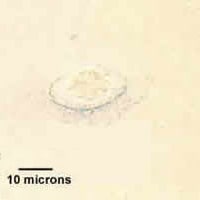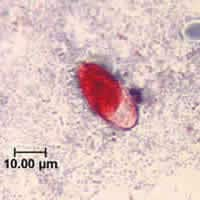
Monthy Case Studies - 2000
Case #43 - September, 2000
A 35-year-old man with AIDS from the Ivory Coast was seen at a hospital in Abidjan. He complained of severe, watery diarrhea accompanied by abdominal pain for more than two months. He had lost a lot of weight because of diarrhea and loss of appetite. A stool sample was collected at the clinic and sent to the central hospital for processing and examination. A modified formalin-ethyl acetate concentration technique was performed and two smears were made from the pellet. The object seen in Figure A shows what was observed in few numbers on the smear, which was stained using modified Kinyoun's acid-fast technique (500×). The other smear was stained using the hot safranin technique. The object seen in Figure B shows an example of what was seen in few numbers on that smear (500×). What is your diagnosis? Based on what criteria?

Figure A

Figure B
Answer to Case #43
This was a case of cystoisosporiasis caused by Cystoisospora belli. Diagnostic features observed were:
- the size of the objects (approximately 24 micrometers in length).
- the shape of the objects (ovoid, with tapered ends).
- presence of a smooth, hyaline wall.
- presence of a large, unsporulated germinal mass.
Please note that oocysts of C. belli may not stain well or uniformly using acid-fast staining techniques (Figure A). Use of the hot safranin technique usually results in more uniform staining of oocysts of both C. belli and Cyclospora cayetanensis (Figure B). If specimens are not fixed, processed, and examined in a timely manner, oocysts may be observed with two sporoblasts.
More on: Cystoisosporiasis
Images presented in the monthly case studies are from specimens submitted for diagnosis or archiving. On rare occasions, clinical histories given may be partly fictitious.
 ShareCompartir
ShareCompartir


